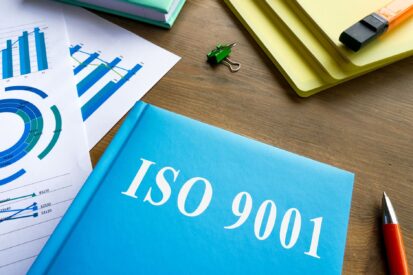Preparing for an ISO 9001 audit is crucial in achieving certification for your quality management system (QMS). A successful audit hinges on having the necessary documentation in place to demonstrate your organisation’s commitment to quality and compliance with the ISO 9001 standard. Having all essential documentation readily available not only facilitates a smoother certification process but also expedites the identification of opportunities for improvement within your QMS.
This blog post will provide a practical resource for Australian businesses preparing for their ISO 9001 audit, outlining an essential documentation checklist. By diligently addressing each item on this list, your organisation can confidently navigate the audit process, showcasing the robustness of your QMS and laying the foundation for continuous improvement and long-term success. Start streamlining your ISO 9001 audit preparation today with this comprehensive checklist tailored to your business’ needs.
1. Quality Management System (QMS) Manual
Your QMS manual is the central guide outlining your organisation’s commitment to quality, the scope of the QMS, and key processes. The manual typically contains an introduction, a description of the business, and overarching company policies that align with ISO 9001 requirements. Key components of the QMS manual include:
- Quality policy and objectives
- Scope of the QMS
- Processes map and description
- Roles and responsibilities of personnel involved in the QMS
The QMS manual should be accessible to relevant personnel and updated as necessary to reflect organisational changes, improvements, and evolving quality objectives.
2. Quality Planning Documentation
Quality planning documentation demonstrates your organisation’s commitment to delivering quality products or services, compliant with customer and industry requirements. These documents should outline your corrective and preventative action plans, risk management strategies, and improvement initiatives. Essential quality planning documents include:
- Quality objectives for each business unit and the organisation as a whole
- Risk management and mitigation strategies
- Quality improvement plans, including a schedule of regular management reviews
Ensure these documents are systematically reviewed and updated to reflect updates in processes, identified risks, and ongoing improvement initiatives.
3. Process Documentation
Process documentation captures each step in your company’s core processes, capturing the inputs, outputs, controls, and interactions between processes. These documents provide a detailed understanding of how your organisation conducts its operations and contributes to its quality objectives. Key process documentation includes:
- Process maps and flowcharts
- Standard operating procedures (SOPs)
- Work instructions and guidelines
Regularly review and update process documentation as your operational practices change to ensure continual alignment with ISO 9001 requirements.
4. Document Control Procedures
Document control procedures establish a process for creating, reviewing, approving, distributing, updating, and disposing of documents within your QMS. This ensures that all internal or external documents maintain consistency and can be easily accessed by relevant personnel. Essential elements of document control procedures include:
- Clear identification of documents, including document title, version, author, and approval status
- Document distribution and accessibility guidelines
- Document update, approval, and review procedures
- Document retention and disposal methods
Develop a robust document control procedure and train relevant staff to ensure all documentation is managed effectively and consistently throughout your organisation.
5. Records and Evidence
Records and evidence provide a trail of your organisation’s compliance with ISO 9001 requirements and the effectiveness of its QMS. These records should be meticulously maintained, stored securely, and easily accessible for audit purposes or internal reviews. Essential records and evidence include:
- Quality records such as inspection, test, and calibration records
- Customer feedback and complaints records
- Corrective and preventative action records
- Internal audit and management review records
Establish a consistent recordkeeping system, including guidelines for document storage, retention, and retrieval, to ensure all quality records are available during audits and reviews.
6. Internal Audit Documentation
Internal audit documentation demonstrates your organisation’s commitment to evaluating its QMS and driving continuous improvement. This includes records of internal audits, findings, and subsequent corrective actions taken. Key internal audit documents include:
- Internal audit plans and schedules
- Audit checklists and criteria
- Audit findings and non-conformities
- Corrective action plans and implementation records
Ensure that internal audits are conducted regularly, findings are documented accurately, and corrective actions are implemented to drive continuous improvement within your QMS.
7. Management Review Documentation
Management review documentation showcases the involvement of top management in the QMS, their commitment to continual improvement, and their efforts to ensure the ongoing effectiveness of the system. Essential management review documentation includes:
- Management review meeting minutes, including attendees, date, and location
- Analysis of data, including feedback from customers, process performance metrics, and non-conformities
- Decisions and actions decided during management review meetings, such as the allocation of resources or establishing new quality objectives
Management review meetings should be held at planned intervals to assess and evaluate the performance and suitability of your organisation’s QMS.
8. Supplier and Subcontractor Evaluation Records
Evaluating suppliers and subcontractors is a critical aspect of managing the quality of products or services provided by your organisation. Key documents related to this process include:
- Supplier evaluation criteria and checklists
- List of approved suppliers and subcontractors
- Records of performance, including any non-conformities or concerns
Regularly re-evaluate suppliers and subcontractors to ensure they meet your organisation’s quality standards and requirements.
Streamline Your ISO 9001 Audit: Expert Guidance at Your Fingertips
Achieving a successful ISO 9001 audit requires thorough preparation, attention to detail, and comprehensive documentation demonstrating your organisation’s commitment to quality and continual improvement. By following this essential documentation checklist, you can confidently navigate the audit process and set your business on the path to certification and success. As you strive to achieve operational excellence, ISO 9001 Consultants is here to support you every step of the way.
Our team of experienced professionals at ISO 9001 Consultants can provide expert guidance, training, and consultation services to help you streamline your audit preparation and enhance your QMS. Ready to support your business in achieving ISO 9001 certification? Schedule a consultation with our experts and explore our personalised services tailored to your specific industry and organisational needs. Let’s work together to make your ISO 9001 audit a seamless experience.








Users Comments
Get a
Quote